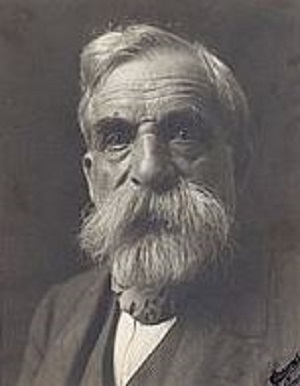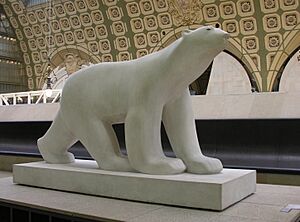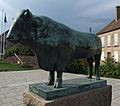François Pompon facts for kids
Quick facts for kids
François Pompon
|
|
|---|---|

Pompon, c. 1918
|
|
| Born | 9 May 1855 |
| Died | 6 May 1933 (aged 77) |
| Nationality | French |
| Education | École nationale supérieure des arts décoratifs |
| Known for | Sculpture |
|
Notable work
|
Ours blanc (White Bear) |
| Movement | Animalier |
François Pompon (born May 9, 1855 – died May 6, 1933) was a famous French sculptor. He was known for making beautiful sculptures of animals. Artists who specialize in animal art are called animaliers. Pompon first showed his art in 1879. He exhibited a statue of Cosette from Victor Hugo's famous book Les Misérables. He was one of the first artists to create modern, simple animal sculptures. But he didn't become truly famous until he was 67 years old. This happened in 1922 with his amazing sculpture called Ours blanc, which means White Bear. Pompon passed away in Paris, France.
Contents
Life and Art of François Pompon
Early Life and Training
François Pompon was born on May 9, 1855, in Saulieu, a town in Burgundy, France. His father was a cabinet maker. When he was 15, Pompon started working as an apprentice. He carved marble for a company that made monuments for graves in Dijon. Soon after, he began studying at the school of fine arts in Dijon.
By 1873, his family had moved to Paris. The city was still recovering from the Franco-Prussian War. Pompon found work helping to rebuild Paris. He started by creating decorations for the new Hotel de Ville de Paris, which is like the city hall.
Beginning His Career as a Sculptor
In 1876, Pompon began studying under a famous animal sculptor named Pierre Louis Rouillard. This was at the École nationale supérieure des arts décoratifs. To earn money, he worked as a craftsman for other well-known sculptors. These included Antonin Mercié and Auguste Rodin. Rodin once told Pompon, "you will be a great artist," after seeing one of his sculptures.
Pompon first showed his work at the Salon (a big art exhibition) in 1879. He showed a statue of Cosette from Les Misérables. In later Salons, he presented some works made of bronze and plaster. Rodin was right about Pompon becoming a great artist. However, it took almost 50 more years for Pompon's unique style to be truly noticed.
He had some small success in 1919. The Musée de Luxembourg bought a stone sculpture of a European turtle dove. After this, the Museum of Grenoble bought three of his plaster works in 1921.
Finding Fame with the White Bear
Widespread recognition finally came when Pompon was 67 years old. This happened at the Salon d'Automne exhibition in 1922. His most famous work, Ours blanc, also known as White Bear or Polar Bear in Stride, was shown there. The final version of this sculpture, made of white stone, is now at the Musée d'Orsay in Paris.
The praise he received in 1922 allowed him to work independently. With this new freedom, he created some of his most important pieces. He made Grand Cerf (Large Deer), a huge bronze sculpture. It was placed in the city of Arnhem in the Netherlands. Next came Taureau (Bull, 1933), which was placed in his hometown of Saulieu.
Pompon mainly used two foundries, Valsuani and Hébrard, to cast his bronze sculptures. Because he became so famous, some other foundries started making fake copies of his work. Many of these fakes were of very poor quality.
Near the end of his life, Pompon gave almost 300 of his works to the Dijon Museum. These included sculptures made of plaster, terracotta, and bronze.
Death and Lasting Impact
François Pompon died in Paris, France, on May 6, 1933. He is remembered as an artist who helped shape modern sculpture. His simple, smooth style influenced other famous sculptors, like Constantin Brâncuși.
Gallery
-
Ours blanc, detail (Musée d'Orsay)
-
Ours blanc (Jardin Darcy, Dijon)
-
Ours blanc (Jardin Darcy, Dijon)
Where to See His Sculptures
You can find François Pompon's sculptures in several museums around the world:
- Musée des Beaux-arts, Dijon, France
- Musée François Pompon, Saulieu, Burgundy, France
- Musée d'Orsay, Paris, France
- Metropolitan Museum of Art, New York, USA
- Middelheim Open Air Sculpture Museum, Antwerp, Belgium
See also
 In Spanish: François Pompon para niños
In Spanish: François Pompon para niños

















